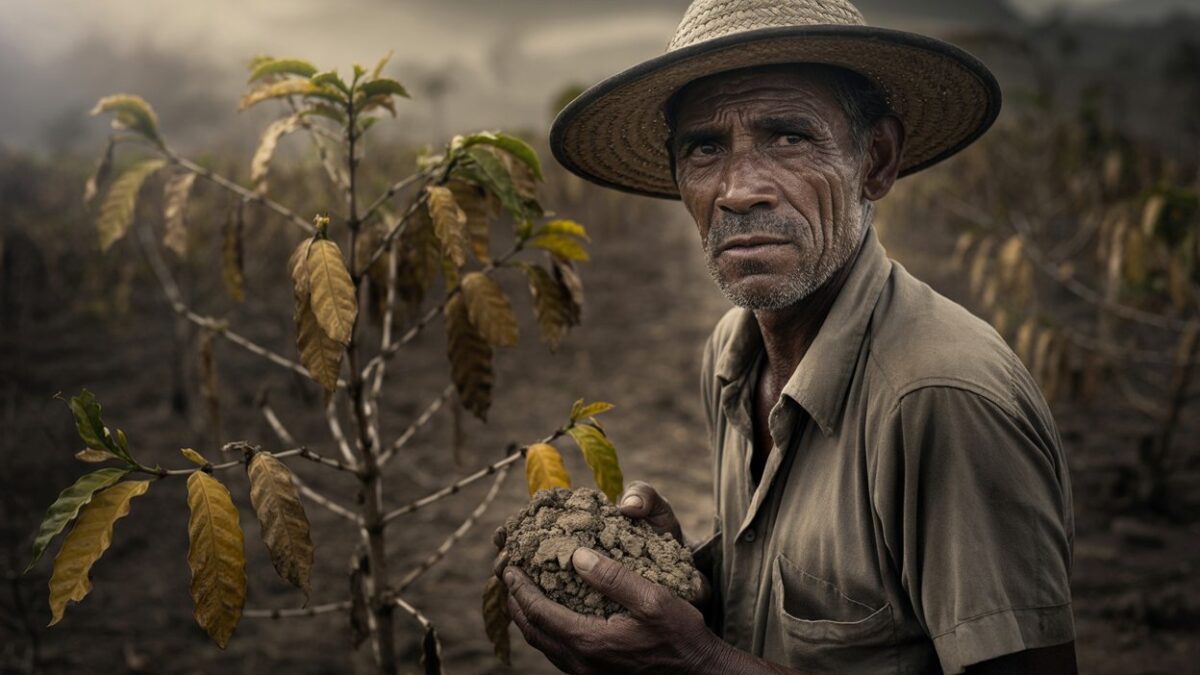
Barista Rob Dunne iki temel Kahve türünü Kahve Uzmanı Giles Hilton ile tartışıyor

Barista Rob Dunne ve Giles Hilton Kahve çekirdeğinin detaylarını tartışıyorlar Fotoğraf: Helen Cathcart
Şimdi ağaçlar genelde, Java’daki küçük tepe çiftliklerindeki ve Brezilya’daki 2.000 dönümlük tarım çiftliklerinde ortaya çıkıyor.
50 ülkede 25 milyon kahve üreticisi bulunmaktadır.Toprak çeşitleri, deniz seviyesine göre yükseklik, lokasyon ve üretim sürecinde kullanılan metodlar vardır , bu sebeple Her üreticinin farklı çekirdek ve aroması olmaktadır.Dünya üzerindeki en sevdiğiniz kahveyi nasıl seçersiniz?
Taze çekilmiş çekirdekler, hazır öğütülmüş kahveye göre genellikle iyi olmaktadırlar.

Giles Hilton ile konuştuk , Kendisi 30 yılı aşkın süredir Whittard Coffe de üretim müdürüydü. Mrs. Hilton şu anda Fortnum ve Mason da danışmanlık işiyle birlikte Kahve ve Çay uzmanlığı işini birleştirdi. Mrs. Hilton güney ve orta Amerikadaki çeşitli kahve üreticileri ziyaret edip, birbirlerine rakip üreticilerin ürünlerini değerlendirdi.
İki temel kahve tipi olan Robusta ve Americano konuştuk.
Robusta küresel olarak kahve üretiminin %20 lik kısmını temsil ediyor.Diyor Hilton .Bu vahşi ve tuhaf bir durum robusto için.Her ne kadar İtalyanlar kahvenin gücünün verdiklerini iddaa etselerde bu çekirdeği aroma için kullanmazlar.
Bu bir doğru Robusta ürünleri acı ,tahtamsı bir tadı var.Yüksek kafein içeriğine sahip Arabica çekirdeğinden ve
Bu doğru. Robusta acı, odunsu ve buruk bir kahve üretir. Arabica’dan daha yüksek kafein içeriğine sahiptir ve böceklere karşı kendini savunabilir, bu nedenle yetiştirilmesi daha kolaydır. Hilton, “En üstün arabicalar Brezilya, Kolombiya, Orta Amerika, Endonezya ve Doğu Afrika’da bulunur” diyor.

Şahsen ben Etiyopya’dan gelen arabikaları en heyecan verici buluyorum çünkü henüz keşfetmediğimiz pek çok kahve var.
Tüm kahve türleri bu iki çekirdekten elde edilse de, inanılmaz bir çeşitlilik ve her damak tadına uygun bir şeyler var.
“Her ülkenin kahvesi kendine özgüdür” diyor Hilton. “Bence Guatemala kahvesi bitter çikolatanın zengin tatlılığına sahip, Java’nınki ağır ve sert bir zenginliğe sahipken Brezilya çekirdekleri en inanılmaz metalik ısırığa sahip.”
“De’Longhi Eletta Cappuccino Top gibi bir çekirdekten fincana kahve makinesi kullanarak birçok farklı çekirdeği deneme fırsatına sahip olursunuz.”
Hilton, dünyanın en popüler kahvesinin, zengin bir kahve tarımı mirasına sahip bir ülke olan Kolombiya olduğunu söylüyor. “1800’lü yılların ortalarından kalma, beşinci nesil kahve yetiştiriciliği yapan eski mülkler var artık.”

Kolombiya’nın iyi ekilmiş, hasat edilmiş ve işlenmiş çekirdekler ürettiği ve bunların lezzetli, temiz kahvelere dönüştüğü doğrudur.
Eğer robusta fasulyesi ile büyüdüyseniz, tercihiniz bu olabilir
“En sevdiğim kahve Monsoon Malabar,” diyor Hilton. “Bu kahve arkadaşım Faiz tarafından Batı Hindistan’ın Malabar sahilinde üretiliyor. Çekirdekler muson rüzgarlarında hafifçe kurumaları için sehpa üzerine seriliyor. Bu, tarçın ve hindistan cevizi kreması notalarıyla lezzetli bir şekilde baharatlı, en eşsiz ve egzotik lezzeti yaratıyor.”
“Ben bir kahve züppesiyim,” diye itiraf ediyor. “Ama iyi kahve sadece biraz daha pahalı. Pahalı şarap almak gibi değil.”
Ayrıca, kahvenin öznelliği düşünüldüğünde, eğer robusta çekirdekleriyle büyüdüyseniz, o zaman tercihiniz bu olabilir.
Robusta kahvesini tattığımda, çocukluğumda babamın bana puro dumanı üflediği zamanları hatırlıyorum. Ağızda aynı tadı bırakıyor.

Hilton’a, inanılmaz çeşitliliği keşfetmeyi sevdiğim için tek bir favori kahve belirleyemeyeceğimi söylüyorum, ancak Etiyopyalılar, Kenyalılar ve Kolombiyalılar için her zaman yumuşak bir noktam olacak.
Bazıları günün farklı saatlerinde farklı kahvelerin tadını çıkarır. Hilton, insanların ilk iş olarak uzun bir kahveden ve belki de sabahın ortasında bir espressodan hoşlandığına inanıyor. “Bu aynı zamanda sosyal bir öğle yemeği veya akşam yemeğinden sonra tercih edilen kahve olma eğilimindedir” diye ekliyor.
Ancak yine de katı ve kesin kurallar yoktur ve ilk iş olarak espresso içmemeniz için hiçbir neden yoktur.
Hasat sürecinin büyüleyici olduğu konusunda hemfikiriz ve en iyi kahvenin, ağacın meyvesinin (kiraz olarak adlandırılır) elle toplandığı küçük üreticilerden geldiği konusunda hemfikiriz. Hilton, “Küçük çiftçiler olgun kırmızı kirazları sizin ve benim bahçeden ahududu ya da elma topladığımız gibi topluyor,” diye açıklıyor.
Brezilya’daki büyük çiftliklerde kirazlar makineyle toplanıyor, ancak bu da hem az hem de fazla olgunlaşmış meyveleri topladıkları anlamına geliyor. Devasa makineler bir kahve fidanını üç saniyede soyabiliyor.
Hilton, “Hepsi derecelendiriliyor ve tasnif ediliyor,” diye belirtiyor. “Kirazlar büyük su tanklarına bırakılıyor ve en kaliteli çekirdekler dibe çöküp dipten toplanıyor.” Buna ıslak işleme deniyor.

“Kirazın sert eti çıkarılır ve içinde çekirdeğin iki yarısının bulunduğu çekirdek kırılarak açılır. İdeal olarak, yedi gün boyunca kurumaları için büyük teraslarda güneşte bırakılırlar.”
İşleme yönteminin farklı unsurlara bağlı olduğunu ekliyorum: konum, suya erişim ve çiftçinin ne kadar varlıklı olduğu.
“Doğru,” diye başını sallıyor Hilton. “Kuru işleme, karakterli iyi bir Etiyopya kahvesi geliştirmek için işe yarayabilir, ancak Orta ve Güney Amerika kahvelerinin zenginliğini mahvedebilir.”
Bu kuru, çiğ çekirdeklerin (bildiğimiz anlamda) kahve tadı yoktur ve bir ya da iki yıl boyunca saklanabilirler. İdeal olarak dört ila altı ay boyunca saklanırlar ve daha sonra menşe ülkeden ihraç edilirler – her ülke kendi kavurmasını yapar.
Hilton ve pek çok kahve içicisinin bunun farkında olduğunu sanmıyorum.
Ama elbette mantıklı: çekirdekleri kavurmak, inanılmaz tadı yaratan yağları açığa çıkarır. Tazelik çok önemlidir – çekirdekler daha uzun süre saklanır ve taze çekilmiş çekirdekler genellikle hazır öğütülmüş kahveden daha üstündür.
Kavurma işlemi olağanüstüdür. Çekirdekler devasa çimento mikserlerine benzeyen bir kaba dökülür ve 10 ila 15 dakika boyunca ısı püskürtülerek döndürülür.
Farklı çekirdekler farklı sürelerde kavrulur. “Örneğin bazı Kenya kahveleri en iyi orta derecede kavrulur – yaklaşık 12 dakika. Yüksek kavurma onu asidik hale getirebilir. Ancak Kolombiya kahvesi tam 15 dakika boyunca yüksek kavrulabilir” diyor Hilton.
Kahveyi doğru şekilde saklayın. Daha fazla dehidrasyonu önlemek için hava geçirmez bir kapta saklayın. Güzel görünebilir ama cam kavanozlarda güneş ışığına maruz kalmak çekirdeklere daha fazla zarar verecektir. Ve buzdolabında saklamayın – nemlenirler ve kıyma ve brokoli kokarlar.
Taze kahve çekirdekleri seçmek sadece başlangıçtır. De’Longhi Eletta Cappuccino Top gibi çekirdekten fincana bir makine kullanmak, kahveyi otomatik olarak hazırladığı ve en iyi kahve tadını elde etmek için çekirdekleri her fincan için taze öğüttüğü için süreçteki belirsizliğin çoğunu ortadan kaldırır.














